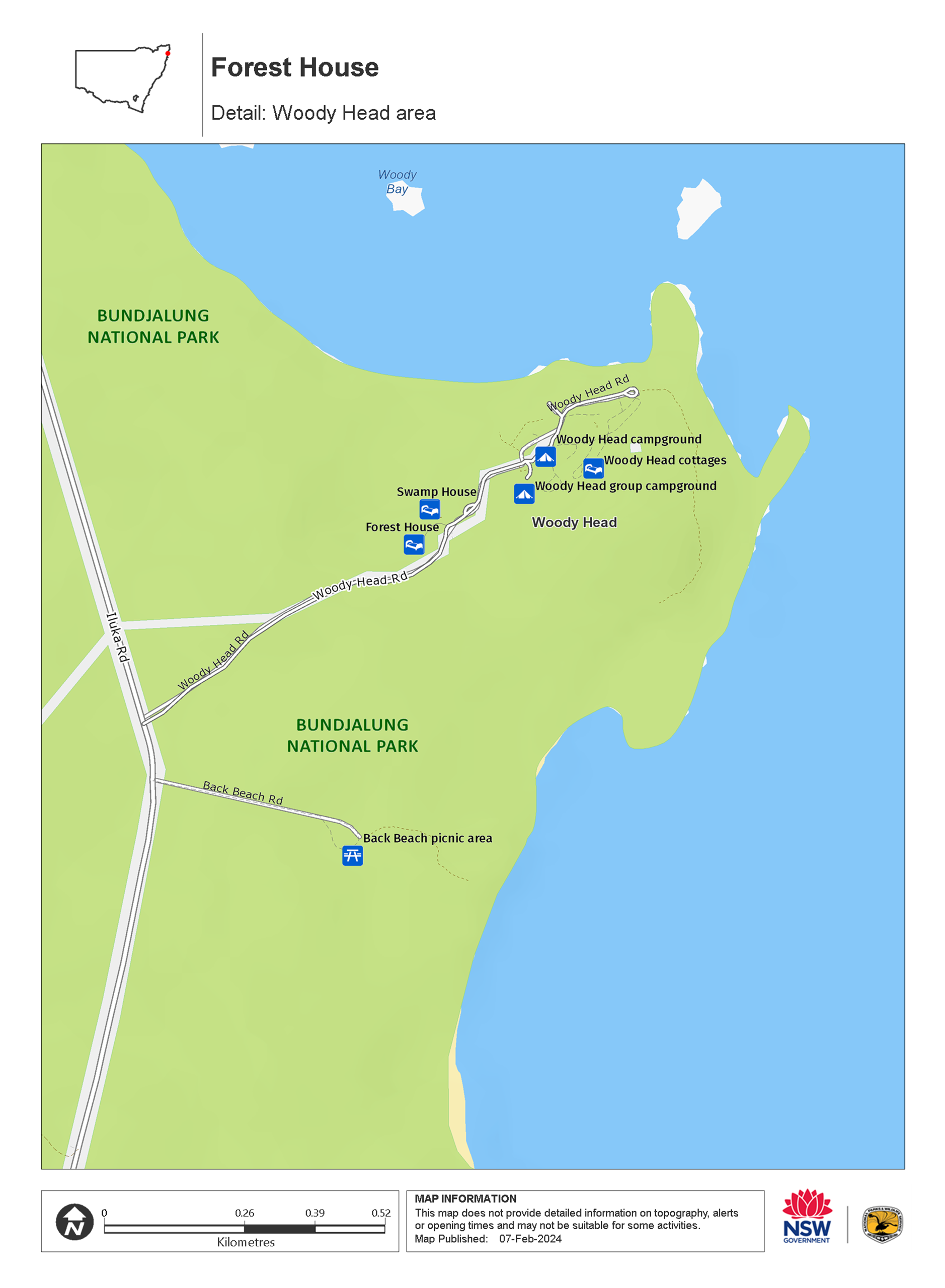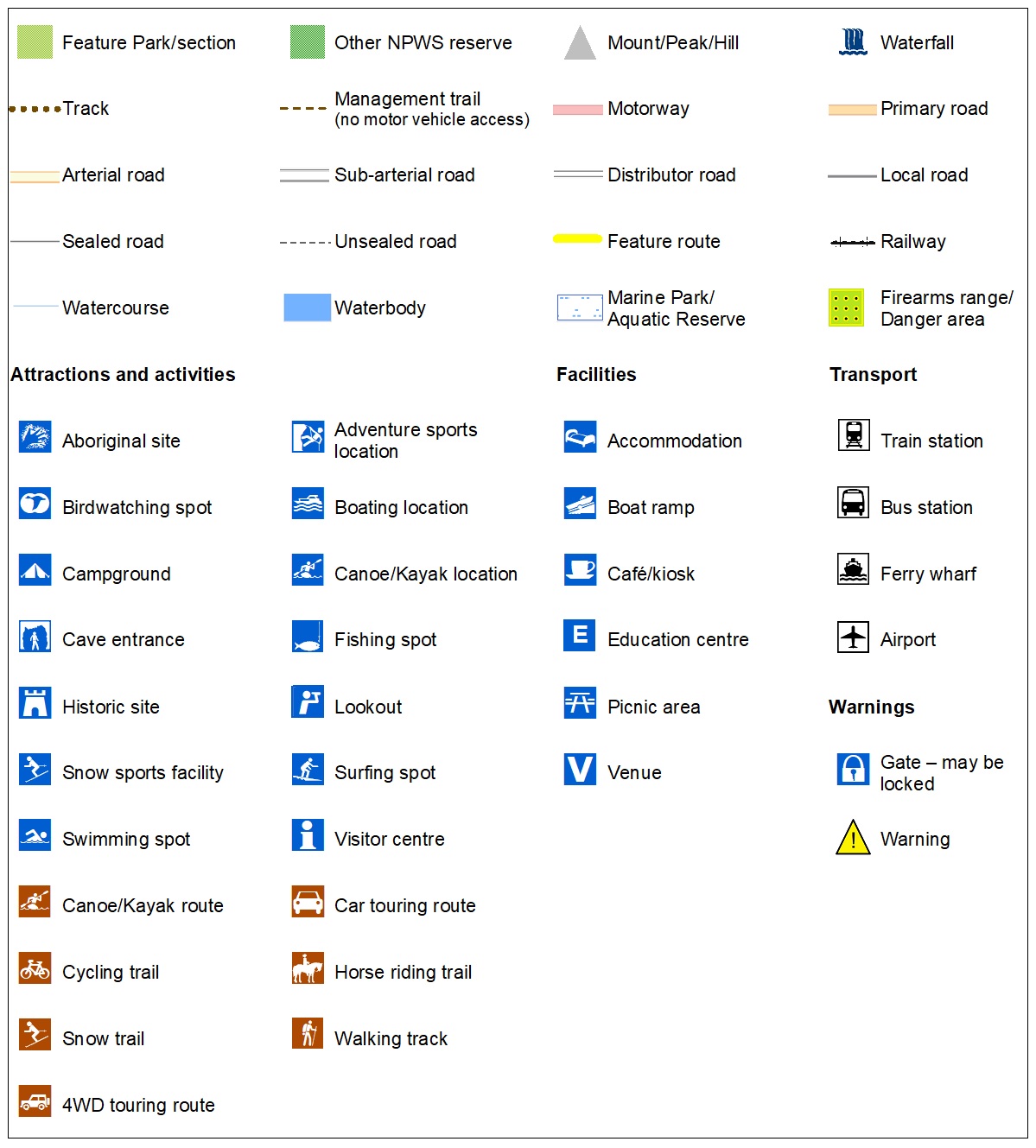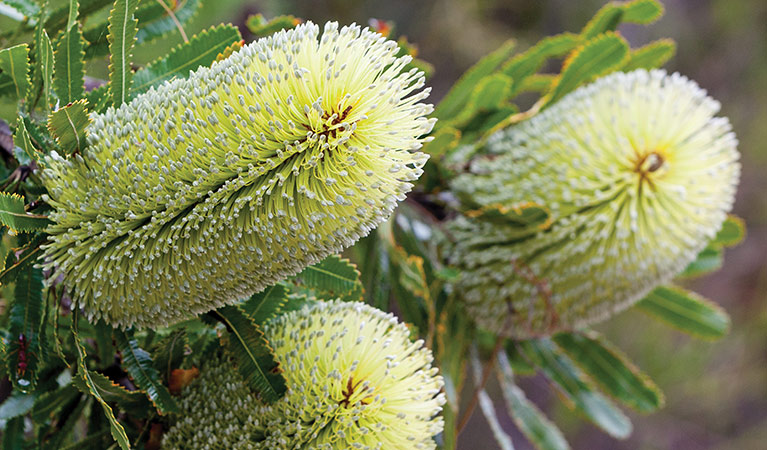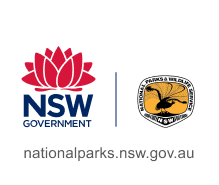Overview
Forest House is great for families or groups looking for a North Coast getaway. It’s nestled in Bundjalung National Park, near Yamba, surrounded by rainforest, rivers and beaches.
| Accommodation type | House |
|---|---|
| Where | 73 Woody Head Road, Woody Head, NSW, 2466 - in Bundjalung National Park |
| Bedrooms | 5 |
| Maximum guests | 12 |
| Facilities | Toilets, showers, drinking water, barbecue facilities, balcony, outdoor furniture, kitchen, plates and cutlery, pots and pans, air conditioning, tv, washing machine, picnic tables, electric power, public phone, carpark |
| What to bring | Bed sheets, blankets, towels |
| Entry fees |
Park entry fees are not included in your accommodation fees. |
| Bookings | Book online or call the National Parks Contact Centre on 1300 072 757. |
| Please note |
|
Forest House is a 5-bedroom house that accommodates up to 12 people. It’s perfect for families or groups of friends who want to explore the NSW North Coast.
Set in a secluded spot, you’re surrounded by coastal rainforest and only 300m from the beach at Woody Head. Go swimming in Woody Bay, drop a line at one of the great fishing spots, or enjoy the spectacular views and spot whales in winter at Iluka Bluff lookout.
Here you’ll find everything you need for a family-friendly getaway. The large lounge room and dining area means there’s plenty of room for everyone to spread out and relax.
After a busy day of exploring, sit on the verandah, deck or picnic tables and watch the kids play on the grassy lawn. As the sun sets, gather around the outdoor fire ring for a classic campfire experience, as the local kangaroos and wildlife graze nearby.
Also see
-

Swamp House and Bunkhouse
Swamp House and Bunkhouse are perfect for large groups exploring Bundjalung National Park, near Yamba. Surrounded by rainforest and close to the beach, enjoy nearby swimming, walks, fishing and paddling.
-

Woody Head cottages and cabins
Woody Head cottages and cabins are retro beach shacks between the rainforest and beach in Bundjalung National Park with swimming, paddling and fishing right nearby.
-

Woody Head campground
Woody Head campground is one of the best places for a weekend getaway camping by the beach. Bring your caravan, camper trailer or tent and don’t forget your fishing rod.
Map

Map legend

Local alerts
For the latest updates on fires, closures and other alerts in this area, see https://www.nationalparks.nsw.gov.au/camping-and-accommodation/accommodation/forest-house/local-alerts
Bookings
- National Parks Contact Centre
- 7am to 7pm daily
- 1300 072 757 (13000 PARKS) for the cost of a local call within Australia excluding mobiles
- parks.info@environment.nsw.gov.au
Park info
- in Bundjalung National Park in the North Coast region
Bundjalung National Park is always open but may have to close at times due to poor weather or fire danger.
-
Park entry fees:
$8 per vehicle per day.
Buy annual pass.
Visitor info
All the practical information you need to know about Forest House.
Getting there and parking
Forest House is located near Woody Head campground in Bundjalung National Park. To get there:
- From the north, take Iluka Road turnoff, 72km south of Ballina on Pacific Highway.
- From the south, take Iluka Road turn off, 56km north of Grafton.
- Drive along Iluka Road, through Woombah, over the Esk River Bridge for 13km, then follow the signs to Bundjalung National Park and Woody Head campground.
Road quality
- Sealed roads
Vehicle access
- 2WD vehicles (no long vehicle access)
Weather restrictions
- All weather
Parking
Parking is available for up to 4 vehicles. A daily vehicle entry fee applies.
Facilities
- There are 5 bedrooms that sleep up to 12 guests.
- Bedding configuration: 1 double bed; 1 king single bunk bed and 1 king single bed; 1 queen bed; 1 king single bunk bed and 1 king single bed; 1 queen bed.
- There are 2 bathrooms and 3 toilets: 1 bathroom has a shower, toilet and bath; 1 bathroom has a shower and toilet; and there’s an additional toilet.
- Open-plan breakfast bar and dining area.
- Lounge room.
- Please remove all your items from the fridge and freezer, and leave the house clean and tidy with all kitchen items washed and put away. Additional cleaning fees may apply if unreasonable cleaning is required, and for missing or broken items.
- You can also use the facilities at Woody Head campground.
Toilets
- Flush toilets
Showers
- Hot showers
Drinking water
Town drinking water is available.
Barbecue facilities
There’s an outdoor fire ring and gas barbecue. You can buy firewood at Woody Head campground kiosk.
- Gas/electric barbecues (free)
- Fire rings
Balcony
Enclosed verandah.
Outdoor furniture
Kitchen
Gas stove and oven, fridge with freezer, microwave, kettle and dishwasher.
Plates and cutlery
Pots and pans
Air conditioning
TV
TV and DVD player.
Washing machine
Internal laundry with a washing machine and dryer.
Picnic tables
Electric power
Public phone
There’s a pay phone near the Woody Head campground office. There’s intermittent mobile phone service at Woody Head but no Wi-fi.
Carpark
Maps and downloads
Accessibility
Disability access level - no wheelchair access
Prohibited
- Please be considerate of others and keep noise to a reasonable level at all times. Minimum noise levels apply between 10pm and 7am.
- Amplified music is not permitted.
Camping
Camping beside the house is not permitted.
Gathering firewood
You can buy firewood at Woody Head campground kiosk.
Generators
Pets
Pets and domestic animals (other than certified assistance animals) are not permitted. Find out which regional parks allow dog walking and see the pets in parks policy for more information.
Smoking
NSW national parks are no smoking areas.
Learn more
Forest House is in Bundjalung National Park. Here are just some of the reasons why this park is special:
An ancient landscape

At Bundjalung National Park you can visit Gummigurrah, an area that was used as a winter camping ground by the Bandjalung People. This park is one of a group where the Bandjalang People's native title rights have been recognised and is only the third determination of native title rights in New South Wales. Native title rights come from the Bandjalang People's traditional laws and customs and legally recognise the Bandjalang People's connection to Country. This means that these lands will continue to be places of ceremony, learning and inspiration for generations to come.
Meet the locals

The varied habitat of Bundjalung National Park is home to over 140 species of fauna. Wake to the morning melodies of eastern whip-birds, bower birds and the rare barred cuckoo-shrike. At dawn and dusk, you might find eastern grey kangaroos, red-necked wallabies and swamp wallabies congregating around your campsites. Scour the tops of nearby trees and you might also catch a glimpse of a sleeping koala or two.
- Iluka Bluff lookout Stay as long as you like to enjoy the views at Iluka Bluff lookout, near Yamba. Not only is it an excellent whale watching spot, it’s also a great place to picnic.
- Jerusalem Creek walk Keep your eyes peeled for birds nesting along the creek along the Jerusalem Creek walk. Enjoy the hike as a day walk or shorter walk and finish up with a picnic lunch.
Water world

Bundjalung protects a variety of environments that feature water, including beaches, rivers, wetlands and lagoons. You'll find different types of plants, animals and birds in each one; look for coast banksia, coast she-oak and coastal wattle on the dunes that back onto the beach. Immerse yourself in this world by canoeing the waterways, rambling in the rock pools and swimming in the ocean.
Plants and animals protected in this park
Animals
-

White-bellied sea eagle (Haliaeetus leucogaster)
White-bellied sea eagles can be easily identified by their white tail and dark grey wings. These raptors are often spotted cruising the coastal breezes throughout Australia, and make for some scenic bird watching. Powerful Australian birds of prey, they are known to mate for life, and return each year to the same nest to breed.
-

Eastern ground parrot (Pezoporus wallicus wallicus)
The eastern ground parrot is a beautiful, ground-dwelling native bird that lives in low heathland habitat along the NSW North and South coasts and escarpments. It’s listed as a vulnerable species in NSW.
-

Peron's tree frog (Litoria peroni)
Peron’s tree frog is found right across NSW. These tree-climbing and ground-dwelling Australian animals can quickly change colour, ranging from pale green-grey by day, to a reddish brown with emerald green flecks at night. The male frog has a drill-like call, which has been described as a 'maniacal cackle’.
-

Emu (Dromaius novaehollandiae)
The largest of Australian birds, the emu stands up to 2m high and is the second largest bird in the world, after the ostrich. Emus live in pairs or family groups. The male emu incubates and rears the young, which will stay with the adult emus for up to 2 years.
-

Koala (Phascolarctos cinereus)
One of the most renowned Australian animals, the tree-dwelling marsupial koala can be found in gum tree forests and woodlands across eastern NSW, Victoria and Queensland, as well as in isolated regions in South Australia. With a vice-like grip, this perhaps most iconic but endangered Australian animal lives in tall eucalypts within a home range of several hectares.
-

Lace monitor (Varanus varius)
One of Australia’s largest lizards, the carnivorous tree-dwelling lace monitor, or tree goanna, can grow to 2m in length and is found in forests and coastal tablelands across eastern Australia. These Australian animals are typically dark blue in colour with whitish spots or blotches.
-

Grey-headed flying-fox (Pteropus poliocephalus)
The grey-headed flying fox is Australia's largest native bat, with a wingspan up to 1m. This threatened species travels up and down south-eastern Australia and plays a vital role in pollinating plants and spreading seeds in our native forests.
-

Australian pelican (Pelecanus conspicillatus)
The curious pelican is Australia’s largest flying bird and has the longest bill of any bird in the world. These Australian birds are found throughout Australian waterways and the pelican uses its throat pouch to trawl for fish. Pelicans breed all year round, congregating in large colonies on secluded beaches and islands.

